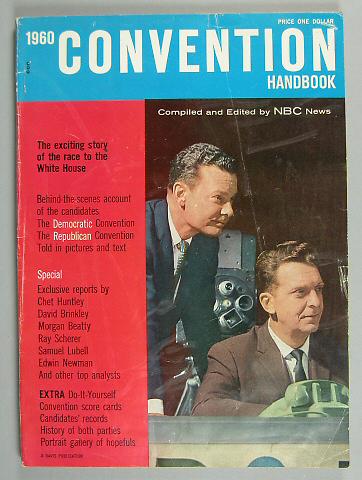The 146 page handbook details both the Democratic and Republican conventions of 1960. The table of Contents is as follows:
The Adventure of Democracy
Broadcasting and Politics
How It All Began
Splinter Parties and How They Grew
THe Challenge of the Presidency
Anatomy of a Convention
Chart of Presidential Elections Since 1900
How Delegates Are Selected
Chart of Presidential Electoral Votes
The Democratic Convention:
Convention City: Los Angeles July 11, 1960
Map of Los Angeles and Main Convention Points
The Democratic Path
Chart of Democratic Convention Nominees since 1832
Gallery of Democratic Leaders
The Democratic National Committee
How the Democrats Apportion Delegates
Map of Democratic Allocation of Votes in 1960 Convention
The Democratic Contenders (Lyndon B. Johnson, John F. Kennedy, Adlai E. Stevenson, Stuart Symington)
Dark Horses and Hopefuls
Scorecard for Democratic Presidential Nomination Balloting
Scorecard for Democratic Viex Presidential Naomination
The Republican Convention:
Convention City: Chicago July 25, 1960
Map of Chicago and Main Convention Points
The Republican Path
Chart of Republican Convention Nominees since 1832
Gallery of Republican Leaders
The Republican National Committee
How the Republicans Apportion Delegates
Map of Republican Allocation of Votes in 1960 Convention
The Republican Contenders (Richard M. Nixon, Nelson A. Rockefeller)
Dark Horses and Hopefuls
Scorecard for Republican Presidential Nomination Balloting
Scorecard for Republican Viex Presidential Naomination
The Candidates Reords: How they voted, What they said
A View from Abraod
From the DIrector's Chair
From the Television Booth
Radio: History in a Hurry
The Role of the South
Odds and Addenda
In Song and
The Democratic National Convention opened in Los Angeles on 10 July 1960, with the strongest civil-rights plank in party history. Kennedy addressed several dozen caucuses during the first two days, and the all-out drive paid off. On 14 July Senator John Kennedy was nominated for the presidency on the first ballet with 806 votes. His nearest rival was Texas Senator Lyndon Johnson with 409 votes. Putting aside the battles they had fought, JFK, with his usual political astuteness, picked Johnson as his running mate. Nixon would be heir to Dwight Eisenhower's Republican throne at the 1960 Republican Convention, held 100 years after the first convention hosted by Chicago--Abraham Lincoln's Wigwam nomination of 1860. The convention was on the verge of being out of control, which prompted Nixon to fly to Chicago to meet with delegations and smooth things over. Nixon sailed to victory, earning 1,321 votes to 10 for the nomination. Nixon's presidential campaign was to be a tough one. He fought Kennedy step for step, but in the end fell just behind. Among other setbacks, Kennedy had taken Chicago by 450,000 votes. The Republicans were bitter about the outcome and the behind-the-scenes scheming, and refused to return to Chicago to stage another national convention.


